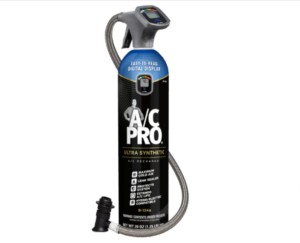Experiencing weak or warm air blowing from your car’s air conditioning vents? You might be facing a common issue: low refrigerant. Recharging your car’s AC system can often restore that refreshing cool air, and surprisingly, it’s a task you can tackle yourself. This guide will walk you through the process of how to recharge your car AC at home, saving you time and money compared to a professional service.
What You Need to Recharge Your Car’s AC System
In the past, AC system recharges were exclusively handled by professionals. However, user-friendly DIY kits have made it accessible for car owners to perform this maintenance themselves. To recharge your AC effectively, you’ll need to gather the following items:
- AC Recharge Kit with Refrigerant: Ensure you select the correct refrigerant type (R-134a or R-1234yf) for your vehicle. This kit typically includes a can of refrigerant and a charging hose.
- Protective Gear: Safety gloves and goggles are crucial to protect yourself from potential refrigerant exposure.
- Pressure Gauge: Many recharge kits include a pressure gauge integrated into the charging hose. This is essential for monitoring refrigerant levels.
- Thermometer: A simple thermometer to measure the air temperature from your AC vents will help you assess the effectiveness of your recharge.
Before proceeding, it’s critical to identify the type of refrigerant your car requires. Consult your vehicle’s owner’s manual or check for a label located under the hood. Using the incorrect refrigerant can severely damage your AC system components.
Prioritize safety and preparation by reviewing the instructions included with your chosen recharge kit thoroughly. Additionally, keep these safety tips in mind:
- Ventilation: Work in a well-ventilated area, ideally outdoors, to avoid inhaling refrigerant vapors.
- Skin Contact Prevention: Refrigerant can cause frostbite upon skin contact, so always wear gloves and avoid direct exposure.
- Avoid Overcharging: Overfilling the AC system with refrigerant can lead to damage. Use the pressure gauge to ensure you add the correct amount.
Step-by-Step Guide to Recharging Your Car AC at Home
Follow these steps carefully to safely and effectively recharge your car’s AC system:
1. Check Ambient Air Temperature and System Pressure
Before you begin, it’s important to check the ambient air temperature. If the temperature is below 55°F (approximately 13°C), do not attempt to recharge your AC system. Low ambient temperatures can affect pressure readings and make accurate charging difficult.
Using a charging hose with a gauge is highly recommended for precision. Refrigerant packaging often includes a temperature-pressure chart to guide you on the correct pressure range based on the ambient air temperature. If a chart isn’t provided, you can use a general AC pressure chart as a guideline (see below). Keep in mind that specific AC systems might have unique recommended pressures, so consulting your vehicle’s repair manual or online resources for your specific model is beneficial. Adhering to these pressure guidelines is crucial for efficient AC system operation and longevity.
While recharging with a single gauge attached to the refrigerant can is possible, using a complete set of manifold gauges offers more comprehensive monitoring. Manifold gauges measure both high and low side pressures, providing a more detailed system analysis. These professional-grade gauges are available for purchase or rent at many auto parts stores.
Start your vehicle and set the air conditioning to the maximum cooling setting. Locate your vehicle’s AC compressor and observe the AC clutch. When the compressor is disengaged (likely due to low refrigerant), only the outer pulley will rotate. When engaged, the entire clutch assembly will turn, driving the compressor. A compressor that doesn’t engage at all often signals very low refrigerant pressure.
2. Locate the Low-Pressure Service Port
Open your car’s hood and identify the low-pressure service port on the AC system. This port is typically situated on the line connecting the accumulator or receiver drier to the compressor. The high-side port, which is larger, is found between the AC compressor and condenser. The low-pressure port is usually marked with an “L” and is located on a larger diameter tubing near the compressor. If you’re unsure of its exact location, consult your vehicle’s service manual for specific guidance.
For DIY recharging using a single hose and gauge refrigerant can, you will only use the low-pressure side. If you are using a set of manifold gauges, you will connect to both the high and low-pressure ports, but for simple recharge, the low-pressure port is sufficient.
Important Note: Vehicles manufactured in 1994 and earlier often used R12 refrigerant. If your vehicle still uses R12, it requires professional evacuation and retrofit before using modern refrigerants. Mixing R12 with other refrigerants is illegal and harmful. Never add refrigerant through the high-side port; this is extremely dangerous and can cause serious injury or system damage. R12 fittings are easily identified as they resemble tire valves with screw-on hose attachments, while R134A fittings are larger quick-connect types.
Also, be aware that starting around 2013, many vehicles began using R1234YF refrigerant. This refrigerant is incompatible with R134A. Troubleshooting and recharging systems using R1234YF are best left to qualified professionals.
3. Clean the Service Port
Use a clean rag to wipe away any dust, dirt, or debris from the low-pressure service port area. Then, remove the protective cap from the port. This ensures a clean connection for the recharge hose.
4. Connect the Recharge Kit
Attach the hose from your AC recharge kit securely to the low-pressure service port. Ensure the connection is firm and properly seated before proceeding to prevent refrigerant leaks.
5. Read the Initial Pressure
Check the pressure reading on the gauge before adding any refrigerant. This initial reading will indicate the current refrigerant level in your system. If the gauge shows pressure within the normal range, adding more refrigerant is unnecessary and could indicate a different AC system problem.
6. Add Refrigerant Gradually and Monitor
Place your thermometer inside a dashboard vent to monitor the vent air temperature. Start your car and turn the AC to the coldest setting with the blower fan on high. Begin squeezing the trigger on the recharge kit to slowly introduce refrigerant into the system in short bursts. Continuously monitor the pressure gauge while adding refrigerant.
You should observe the AC compressor clutch engaging as the low-side pressure reaches approximately 25-30 PSI. Stop adding refrigerant once the pressure reaches the recommended level indicated on your pressure chart or the general guideline, and when the air blowing from the vents becomes noticeably colder. In typical 70-80°F (21-27°C) outside temperatures, the vent temperature should drop to around 35-48°F (2-9°C).
7. Disconnect and Store
Once the AC system is charged to the correct pressure and you have achieved cold air from the vents, carefully disconnect the charging hose from the low-pressure service port. Leave the refrigerant can attached to the charging hose for now. Store any remaining refrigerant in a cool, dry place, away from direct sunlight and heat.
8. Inspect and Reinstall Service Port Cap
Before reinstalling the service port cap, examine the seal beneath it. Ensure the seal is free from cracks, nicks, or tears. A healthy seal provides an extra layer of protection against leaks from the Schrader valve within the service port. Reinstall the cap securely.
Common Mistakes to Avoid During AC Recharge
While recharging your car’s AC is a straightforward DIY task, avoiding common mistakes is essential for success and to prevent damage:
- Overcharging the System: Adding too much refrigerant can cause excessive pressure, potentially damaging the compressor and reducing cooling efficiency. Always rely on the pressure gauge and temperature chart for accurate charging.
- Ignoring Refrigerant Leaks: Recharging is not a fix for refrigerant leaks. If your AC stops blowing cold air shortly after recharging, suspect a leak. Locate and repair any leaks before adding more refrigerant. Repeatedly recharging a leaking system is inefficient and environmentally unfriendly.
- Using Incorrect Refrigerant: Vehicles have specific refrigerant requirements. Always use the refrigerant type specified for your car to avoid system damage and ensure proper operation.
AC Pressure Chart for R-134a Refrigerant
Refer to this chart as a general guideline for R-134a refrigerant pressure based on ambient temperature. Always prioritize any specific pressure recommendations from your vehicle’s manufacturer or the refrigerant product instructions.
After successfully recharging your AC, you should notice a significant improvement in cooling performance immediately. It’s advisable to recheck the pressure a day or two after recharging to ensure the system is holding pressure. If you suspect a leak is the reason for low refrigerant, use a UV leak detection kit. Introduce UV dye into the system and use a UV light to inspect AC components for dye traces, revealing the leak location.
When Professional AC Service is Necessary
If your car’s AC cooling doesn’t improve after a recharge, or if cooling diminishes quickly after a recharge, it indicates a more complex issue. Potential problems could include a clogged expansion valve, a failing AC compressor, or a significant refrigerant leak. If the compressor clutch isn’t engaging even after recharge, professional diagnosis is necessary.
In these situations, it’s best to seek professional AC service from a qualified technician. They can accurately diagnose the underlying problem and perform necessary repairs before recharging the system.
AutoZone offers a wide selection of refrigerants, recharge kits, and AC repair parts to help you maintain your car’s AC system.
Find a Nearby AutoZone Store
For more in-depth automotive repair information, consider ALLDATAdiy, which provides DIYers with access to professional-level repair data for single-vehicle subscriptions.
Related: Car Heater Blowing Cold Air
Learn More about ALLDATAdiy
Frequently Asked Questions (FAQ)
How often should I recharge my car’s AC?
Typically, car AC systems should not require frequent recharging unless there’s a leak. If you notice a decline in cooling performance, it’s a good time to check refrigerant levels.
What are the consequences of overcharging my car’s AC system?
Overcharging can create excessive pressure within the AC system, potentially causing damage to the compressor and other components, as well as reducing cooling efficiency.
How can I determine if my AC system has a refrigerant leak?
Signs of a refrigerant leak include a sudden loss of cooling, hissing sounds from the AC system, or visible oily residue near AC components.
Is it possible to recharge my car’s AC without using a pressure gauge?
It’s strongly discouraged. A pressure gauge is essential for ensuring you add the correct amount of refrigerant and prevents harmful overcharging.
Why is my car AC still blowing warm air even after recharging?
If warm air persists after recharging, it could indicate a refrigerant leak, a malfunctioning compressor, or blockages within the AC system components. Professional diagnosis is recommended in these cases.

